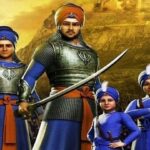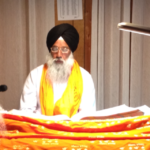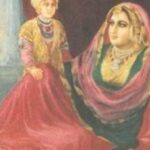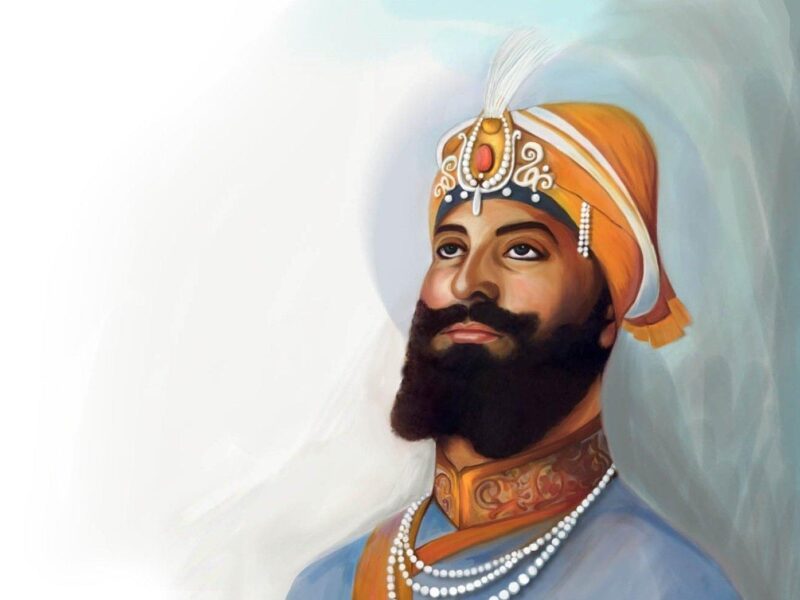Remembering the Sacrifice: Shaheedi Diwas of Baba Zorawar Singh Ji, Baba Fateh Singh Ji, and Mata Gujar Kaur Ji
On the 26th of December, the Sikh community commemorates the Shaheedi Divas (martyrdom day) of the younger Sahibzaadey, Baba Zoravar Singh (aged 7) and Baba Fateh Singh (aged 5), along with the revered mother of Guru Ji, Mata Gujjar Kaur Ji.
Table of Contents
ToggleUnderstanding the Significance of Shaheedi Diwas
Shaheedi Diwas, or Martyrs’ Day, holds a sacred place in Sikh history, marking the supreme sacrifices made by individuals who fearlessly embraced martyrdom for the sake of righteousness and the Sikh principles. This day is particularly poignant as it allows us to reflect on the valor, unwavering faith, and resilience displayed by those who laid down their lives for the greater good. Among these revered figures are the Chaar Sahibzaade—Baba Ajit Singh, Baba Jujhar Singh, Baba Zorawar Singh Ji, and Baba Fateh Singh Ji. Their selfless devotion to Sikhism and their steadfast courage serve as a beacon, guiding us to delve into the profound importance of Shaheedi Diwas and the enduring legacy it has left on the Sikh community.

Defining Shaheedi
At its core, Shaheedi Diwas is a commemoration of martyrdom, a term deeply rooted in Sikh philosophy. The word “Shaheedi” itself carries a weighty significance, embodying the idea of selfless sacrifice for a just cause. Sikhism teaches that martyrdom is a path to spiritual elevation, and those who embrace it are revered for their courage and commitment to righteousness.
Historical Context
Understanding the historical context surrounding Shaheedi Diwas is crucial. The Sikh community has witnessed numerous instances where individuals, driven by their unwavering faith, chose martyrdom over compromising their principles. The day is especially associated with significant events in Sikh history, such as the sacrifices of Guru Arjan Dev Ji, Guru Tegh Bahadur Ji, and the valiant sons of Guru Gobind Singh Ji, Baba Zorawar Singh Ji and Baba Fateh Singh Ji.

The Spiritual Dimension
Symbolism in Sikhism
In Sikhism, martyrdom is not viewed as an end but as a continuation of the spiritual journey. It symbolizes the triumph of righteousness over tyranny and the eternal nature of the soul. The Sikh Gurus themselves set powerful examples, emphasizing that one’s commitment to truth should be unyielding, even in the face of adversity.
Spiritual Elevation
Shaheedi Diwas is an occasion to reflect on the spiritual elevation attained by those who willingly faced persecution and death. It is believed that such souls, having demonstrated exceptional courage and devotion, achieve a higher state of consciousness, becoming sources of inspiration for generations to come.
Lessons from Martyrdom
Courage and Conviction
The stories of those who attained martyrdom inspire individuals to cultivate courage and conviction in their own lives. Shaheedi Diwas serves as a reminder that staying true to one’s principles requires immense strength, and the path of righteousness may demand sacrifice.
Unity and Solidarity
The commemoration of Shaheedi Diwas fosters a sense of unity and solidarity within the Sikh community. It reinforces the idea that the values upheld by the martyrs are collective treasures, binding the community together in a shared commitment to justice, equality, and compassion.
Contemporary Relevance
Social and Political Relevance
Shaheedi Diwas is not confined to the pages of history; it resonates in contemporary times. The principles for which individuals sacrificed their lives remain relevant, serving as a moral compass for addressing social injustices and advocating for human rights.
Inspirational Leadership
Leadership inspired by the spirit of martyrdom is transformative. Individuals who draw inspiration from the sacrifices made on Shaheedi Diwas contribute to positive societal change, standing against oppression and upholding the values of justice and equality.
Commemoration Rituals and Practices
Kirtan and Katha
Shaheedi Diwas is commemorated with religious fervor, including recitation of Gurbani, kirtan (devotional singing), and katha (narration of Sikh history). These rituals not only pay homage to the martyrs but also provide an opportunity for spiritual reflection.
Langar Sewa
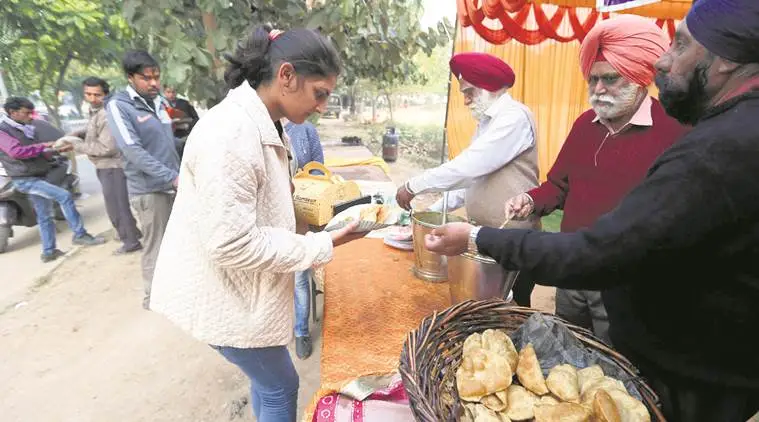
Community service, particularly in the form of langar sewa (serving free meals), is an integral part of Shaheedi Diwas observances. It symbolizes the Sikh principles of selfless service and equality.
Shaheedi Diwas is not just a historical event but a living tradition that continues to shape the identity and ethos of the Sikh community. It serves as a testament to the indomitable spirit of those who, in the face of adversity, chose martyrdom over compromise. As we commemorate Shaheedi Diwas, let us draw inspiration from the selfless sacrifices of the martyrs and strive to embody the principles they upheld — a commitment to truth, justice, and the well-being of humanity.
Guru Gobind Singh Ji’s Courage at Anandpur Sahib: A Stand Against Adversity
In the historical backdrop of Anandpur Sahib, the courageous Tenth Guru of the Sikhs, Sri Guru Gobind Singh Ji, resided alongside his followers and Sahibzadas within the fortress. It was at this sacred site that Guru Sahib, on the auspicious day of Vaisakhi in 1699, instituted the Khalsa and bestowed the blessings of equality, vehemently rejecting all forms of discrimination.
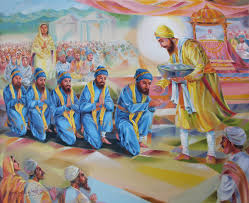
Pahari Raaje and Mughal Army Besiege Anandpur Sahib:
However, the establishment of the Khalsa and the promotion of equality aroused jealousy among the Hindu Kings of the Hills, commonly known as Pahari Raaje, and the Mughal Emperor. This resentment culminated in a joint military offensive against Anandpur Sahib. The combined forces of the Mughal and Pahari Raaje surrounded the Qila (fortress) of Anandpur Sahib, presenting Guru Sahib with an ultimatum to vacate the fort. This marked the beginning of a challenging chapter in Sikh history, testing the resilience and fortitude of Guru Gobind Singh Ji and his devoted followers.
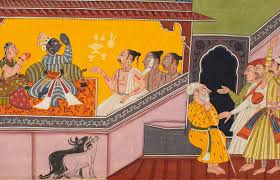
Broken Oaths and the Tragic Exodus from Anandpur Sahib
Assurance of Safe Passage Betrayed:
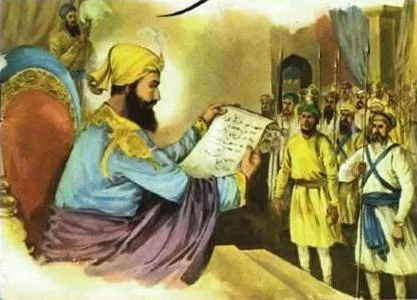
The Mughal Emperor Aurangzeb and the Hindu Kings of the Hills, the Pahari Raaje, conveyed a solemn message, accompanied by an oath, assuring Guru Sahib Ji and the Sikh community that if they abandoned the fortress of Anandpur Sahib, they would be granted safe passage to go wherever they desired.
Guru Ji’s Reluctant Departure:
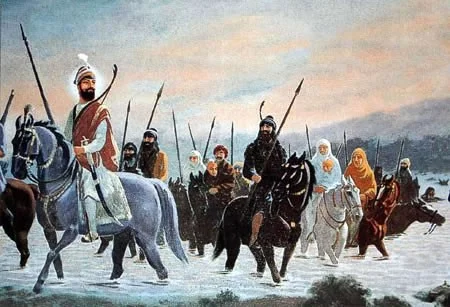
Despite harboring doubts, Guru Gobind Singh Ji, influenced by the pleas of his devoted Sikhs, reluctantly agreed to vacate the fort. Unfortunately, the unfolding events mirrored the Guru’s initial apprehensions.
Family Separation at Sirsa River:
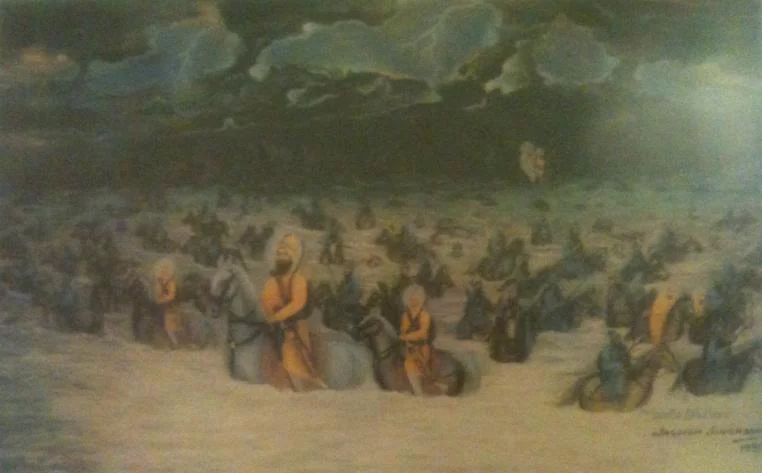
Amidst the chaos of battle, the family of Guru Gobind Singh Ji became tragically separated at the Sirsa River. This heart-wrenching incident is commemorated today by the Gurudwara Parivar Vichora, marking the poignant separation of the Guru’s family. The two younger sons, Sahibzada Zorawar Singh and Sahibzada Fateh Singh, along with Guru Ji’s revered old mother, Mata Gujri Ji, embarked on a perilous journey through dense forests and challenging terrains.
Betrayal Unleashed: As the Sikhs exited the fort, the Mughal Army immediately launched an assault, breaking their sworn promises. A fierce battle erupted on the banks of the Sirsa River, where valiant Sikhs exhibited unparalleled courage, taking down several Mughal soldiers before making the ultimate sacrifice.
Chamkaur Battle
After parting ways, Guru Gobind Singh and the two elder Sahibzadas, Baba Ajit Singh and Baba Jujhar Singh, reached Chamkaur.
The Battle of Chamkaur, also recognized as the Battle of Chamkaur Sahib or the Second Battle of Chamkaur, transpired between the Khalsa, commanded by Guru Gobind Singh, and the coalition forces of the Mughals led by Wazir Khan and Hindu hill chiefs. Guru Gobind Singh later alludes to this battle in his letter, Zafarnama.
After the sacrifice of 35 Sikhs in the battlefield of Chamkaur, Guru Gobind Singh’s elder son, Ajit Singh, prepared to join the fight. While Guru Ji personally trained him, the younger son, Jujhar Singh, began to cry. Not out of fear of going to battle, but because being younger, he lamented not being given the opportunity earlier. Their martyrdom is a golden chapter in Sikh history.
The Battle of Chamkaur lasted for two consecutive days, with Sikhs witnessing one martyr after another. Inspired by the sacrifices, the elder Sahibzadas also sought permission to join the battle. Guru Gobind Singh granted them permission to engage in the fight. Subsequently, the Sahibzadas began to inflict heavy casualties on the Mughal soldiers one by one. However, after some time, both Sahibzadas attained martyrdom in the battle.
Leading up to the Battle
After departing from Anandpur Sahib on the night of December 5 or 6, 1704, Guru Gobind Singh, accompanied by his disciples, crossed the Sarsa River. During their crossing, they were ambushed by Mughal and hill chief forces. Seeking refuge for the night in the garhi or haveli of the city chief, Guru Gobind Singh and his followers were initially denied permission. However, his younger brother granted the Sikhs shelter in the haveli.
The Battle Unfolds
Despite assurances of safe conduct, Mughal soldiers, eager to claim Guru Gobind Singh’s head as a trophy, besieged the haveli where the Sikhs sought shelter. The actual battle reportedly occurred outside the haveli where Guru Gobind Singh was resting. In the midst of the battle, a council of Panj Piare advised the Guru to leave the battlefield to safeguard his life and continue leading the Sikhs. Following their counsel, negotiations failed, and Sikh soldiers confronted the overwhelming Mughal forces, allowing their Guru to escape. To deceive the Mughals, another Sikh, Sangat Singh, donned Guru’s attire and stayed with the soldiers. Unfortunately, the remaining Sikhs were killed by Mughal forces the next morning.
Guru Gobind Singh ji also wanted to participate in this battle, but other Sikhs, utilizing their authority, prevented Guru Sahib from entering the battlefield and asked him to leave. Guru Sahib had to leave forcibly. After this, he fought in the Sikh field and became a martyr. After leaving from there, Guru Gobind Singh ji reached a village where he met Bibi Harsharan Kaur, who held great reverence for the Guru.
When she learned about the martyrdom of Sikhs and Sahibzadas in the battle, she quietly reached Chamkaur and began the last rites of the martyrs, against the wishes of the Mughals who wanted to feed their corpses to vultures. As soon as the Mughal soldiers saw Bibi Harsharan Kaur, they also handed her over to the fire, and she too became a martyr.
Expressing pride in his sons who died in battle, Guru Gobind Singh stated that he had ‘thousands of sons – the Singhs.’ He also conveyed his distrust in Aurangzeb due to the broken vow he took on the Quran.
Zafarnama
Zafarnama, meaning “Epistle of Victory,” is a letter written by Guru Gobind Singh to the then Mughal Emperor Aurangzeb. It vividly recounts the events at Chamkaur and holds Aurangzeb accountable for the occurrences and promises he broke. Following his escape from Chamkaur, the exhausted Guru, carried by two Pathans named Ghani Khan and Nabi Khan, reached Jatpur. There, he was received by a local Muslim chieftain and later proceeded to Dina, where he stayed at the house of Mayi Desan ji, composing the “Zafarnama” in Persian, consisting of 111 verses.
Gurudwara Parivar Vichora
Amidst the tumultuous battleground, the family of Guru Gobind Singh Ji faced a heart-wrenching separation at the Sirsa River. Notably, Gurudwara Parivar Vichora now stands as a poignant memorial at this historic site, commemorating the tragic dispersion of the Guru’s family.
The two younger sons, Sahibzada Zorawar Singh and Sahibzada Fateh Singh, accompanied by Guruji’s revered mother, Mata Gujri Ji, embarked on a courageous journey through dense forests and challenging terrains.
Journey of the Chotte Sahibzade through the Jungle: Encountering wild animals, including lions and snakes, the brave Sahibzadas fearlessly pressed on, guided by their grandmother. Amidst this perilous journey, they recited the sacred hymns of their Gurus, finding solace in the stories of Sikh History narrated by their grandmother. Their unwavering spirit allowed them to traverse the journey comfortably.
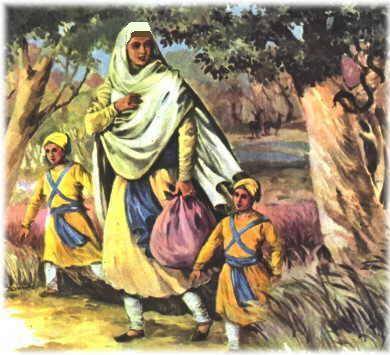
Vadde Sahibzade Cross the River to Chamkaur di Garhi:
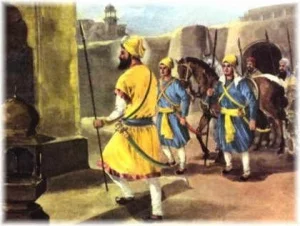
On the other hand, the two elder brothers, Sahibzada Ajit Singh Ji and Sahibzada Jujhar Singh Ji, accompanied their father, Guru Gobind Singh Ji. After crossing the Sirsa River, they spent the night at Ropar and reached Chamkaur di Garhi, the Little Fort of Chamkaur, early the next morning.
Mata Ji and Chotte Sahibzade Find Shelter at Kuma’s Cottage: Following an arduous journey, Mata Gujri Ji and the two young Sahibzadas sought refuge at the humble abode of Kuma, a devoted Muslim water carrier. Overwhelmed by Mata Ji’s presence, Kuma, with folded hands, requested her to bless his cottage by staying there for the night. Pleased with his devotion and as darkness fell, Mata Ji decided to halt there for the night.
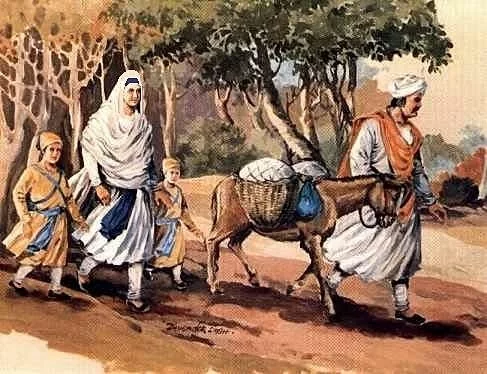
Gangu’s Persuasion and Midnight Betrayal: The next morning, Gangu, a former cook of Guru Ghar, arrived and urged Mata Ji to accompany him to his village, assuring her safety from the Emperor’s officials. Despite initial reluctance, Mata Ji, on persistent requests, agreed. Laden with their belongings on a pony, they set out for Gangu’s village. The young Sahibzadas, Zorawar Singh Ji and Fateh Singh Ji, walked alongside their grandmother, inquiring about their father and elder brothers.
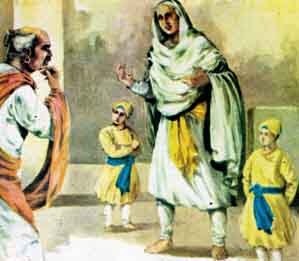
Arrival in Village Kheri and Gangu’s Greed: After a day-long journey, they reached the village Kheri. In Gangu’s house, Mata Ji settled their belongings in a room corner, and Sahibzadas Zorawar Singh Ji and Fateh Singh Ji changed into fresh clothes, recited evening prayers, and slept in their grandmother’s embrace. However, at midnight, Gangu attempted to steal gold coins from Mata Ji’s possession.
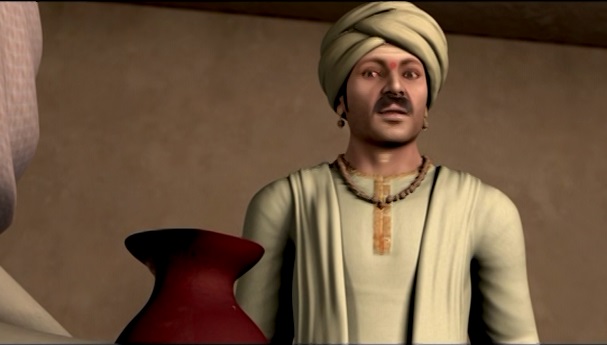
Confrontation with Gangu and False Accusations: The next morning, as Mata Ji discovered the theft, Gangu feigned ignorance and rushed out, falsely claiming a theft. Mata Ji, trying to pacify him, even offered to let him keep the gold coins. However, Gangu, angered by suspicion, accused Mata Ji and created a commotion, shouting about the alleged theft.
Gangu Reports to the Police: Refusing to listen to reason, Gangu left for the Morinda Police station, reporting to the Kotwal that Guru Gobind Singh’s mother and two sons were hiding in his house. His intention was to keep the stolen gold coins for himself after the arrest of Mata Ji and Sahibzade.
Police Raid on Village Kheri: The Kotwal, pleased with this information, dispatched constables with Gangu to arrest them. When the constables arrived at Gangu’s house, they found Mata Gurji Ji and the two Sahibzadas sitting calmly. They informed them of the Kotwal’s orders for their arrest. Subsequently, Mata Ji and the Sahibzadas were taken into custody by the police.
Mata Ji and Sahibzade’s Stoic Acceptance of Arrest: In the haunting image captured at the police station, Mata Gujri Ji tenderly embraced her two Sahibzadas, Sahibzada Zorawar Singh Ji and Sahibzada Fateh Singh Ji, who stood ready to face the impending ordeal. Accompanied by constables, the trio walked through a small crowd gathered outside Gangu’s house. Gangu, with downcast eyes, faced the curses of people who condemned his dishonesty and betrayal.
Public Outcry and Divine Composure: Witnessing the scene, a woman expressed her disdain for Gangu, highlighting the treachery of bringing Mata Ji and Sahibzadas to his house only to inform the authorities later. The public wondered why these innocent Sahibzadas and revered Mata Ji were being escorted to the police station. However, there was no fear on their faces; instead, they walked with grace and divine composure, leaving a lasting impression on onlookers.
Night in Police Custody: At the police station, Mata Gujri Ji and the two Sahibzadas were lodged in the Kotwali for the night. Despite the dire circumstances, the brothers listened to tales of bravery, including the unique martyrdom of Sri Guru Arjun Dev Ji and Sri Guru Tegh Bahadur Ji, narrated by their affectionate grandmother. The trio joined in reciting the sacred evening Nitnem, Sikh daily prayers – Rehraas and Kirtan Sohila – before retiring for the night.
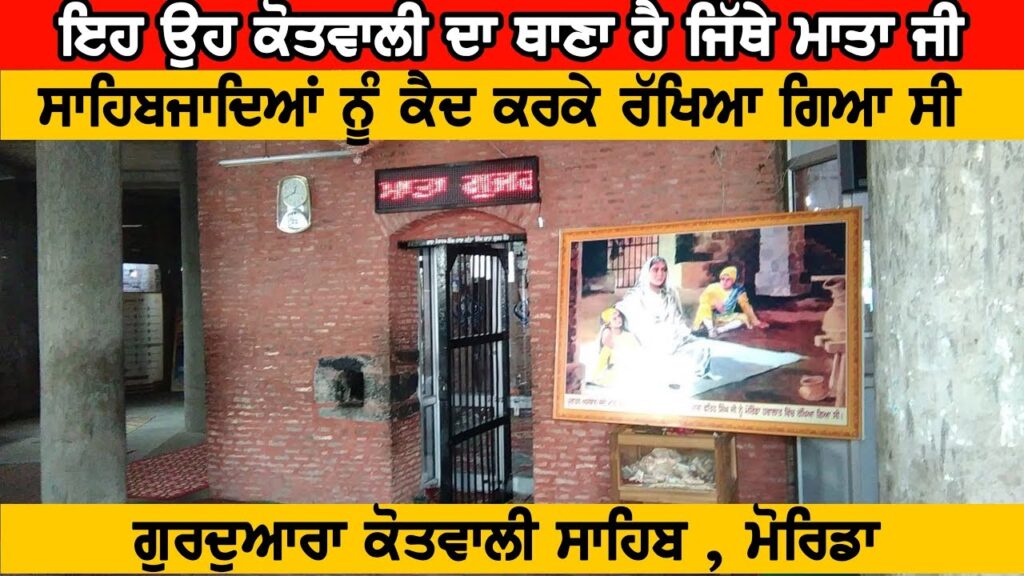
Journey to Bassi Police Station: The news of their arrest spread rapidly, drawing large crowds along the way. People marveled at the sight of the young, innocent Sahibzadas being arrested with their venerable grandmother. The fearless demeanor of the Sahibzadas garnered admiration, with onlookers expressing, “They are the brave sons of their brave father.” The constables, uneasy under the scrutiny, hastened their pace, and the cart-driver urged the bullocks to move swiftly towards Sirhind.
Lodging at Thanda Burj, Sirhind: On reaching Sirhind, they were lodged for the night in Thanda Burj, a tower with no walls to shield them from the chilling December breeze. The cold nights were challenging, but the unwavering spirit of Mata Ji and the Sahibzadas remained resilient.
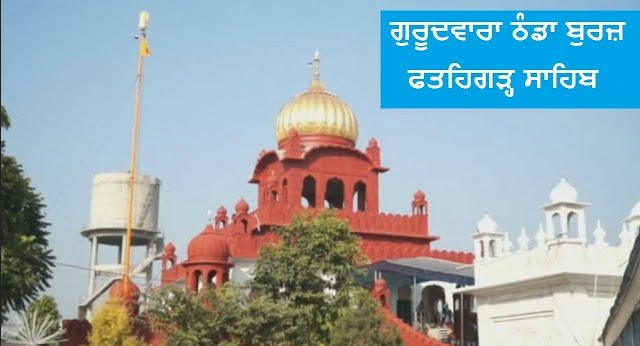
Devotee’s Heroic Act – Baba Moti Ram Mehra Ji: In a remarkable display of devotion, Baba Moti Ram Mehra Ji risked his life to send milk for Mata Ji and the Sahibzadas. This act of service is remembered among Sikhs with the saying, “Dhan Moti Jis Punn Kamaya – Gur-Laalan taain Dudh Piaya” (Baba Moti Ram Mehra Ji’s service is great; he fed milk to the children of Guru Sahib Ji). Unfortunately, Emperor Sirhind later ordered Baba Moti Ram Ji’s execution, along with his family, for his service and devotion to Mata Ji and Sahibzade. They were martyred (Shaheedi) by being crushed in a mill roller.
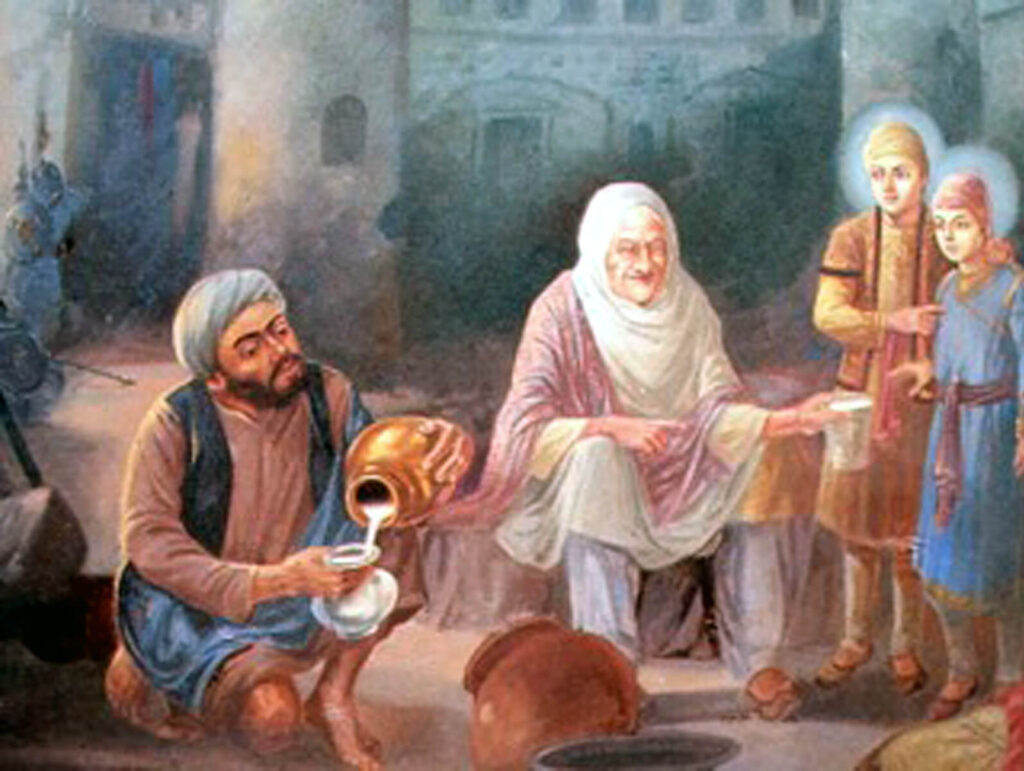
Baba Moti Ram Mehra (late 17th century – early 18th century) was a devout Hindu disciple and a servant of Guru Gobind Singh. He fearlessly entered Thanda Burj, a cold tower, in a dramatic manner to successfully provide milk to Mata Gujri Ji and the Sahibzadas. Gujri, along with Baba Zorawar Singh and Baba Fateh Singh, the two young sons (Sahibzadas) of Guru Gobind Singh, had been imprisoned by the Mughal Governor Wazir Khan of Sirhind for three nights.
Moti Ram was born into a Punjabi Jhinwar family, and his parents were Bholi and Hariya Ram. His uncle, Himmatt Rai Ji, was a member of the first Panj Pyare. On December 27, 1704, the Sahibzadas were martyred, and Mata Gujri Ji decided to leave for the heavenly abode. She made arrangements for their cremation with sandalwood. Someone informed the Nawab that his servant had served milk and water to the prisoners. The Nawab ordered the arrest of Baba Moti Ram Mehra, his mother, wife, and son. Despite facing capture, Moti Ram courageously told the Nawab that serving the imprisoned children and their grandmother was his sacred duty. Therefore, Baba Moti Ram Mehra, along with his family, was squeezed to death in a Kolhu (oil press) in Kohlu (oil press) for his sacrifice.
His sacrifice and teachings were later remembered by Baba Banda Singh Bahadur. Baba Moti Ram Mehra’s followers and relatives formed the Amar Shaheed Baba Moti Ram Mehra Charitable Trust. A memorial Gurudwara, known as Baba Moti Ram Mehra Memorial Gate, was constructed by the trust, situated 200 meters in front of Rauza Sharif, near Gurudwara Fatehgarh Sahib. The land for the memorial was donated by the Bhoomi Shiromani Gurudwara Prabandhak Committee. The Sikhs hold Baba Moti Ram Mehra in high regard for his selfless service and sacrifice. The memorial gate was constructed by the Punjab government in honor of his great sacrifice.
Transmission of Ancestral Narratives – Baabaniya-Kahaniya: In the sacred confines of their tumultuous journey, Sahibzada Baba Zorawar Singh Ji and Sahibzada Baba Fateh Singh Ji found solace in the repository of ancestral stories, Baabaniya-Kahaniya, shared by their venerable grandmother. These sakhis (true stories) unraveled the tapestry of Sikh history, recounting the teachings and sacrifices of Guru Nanak Sahib Ji, the shaheedi (martyrdom) of Guru Arjun Dev Sahib Ji, and the valorous stand of Guru Tegh Bahadur Sahib Ji. Enthralled by the ideals set by the Gurus, the young Sahibzadas, with unwavering determination, assured Mata Ji that they would steadfastly adhere to their faith and tread the illustrious path laid by their father, Guru Gobind Singh Ji.
Summons to Nawab Wazir Khan’s Court: The next morning, the somber arrival of police constables signaled a fateful summons for Sahibzada Baba Zorawar Singh Ji and Sahibzada Baba Fateh Singh Ji to appear before Nawab Wazir Khan’s court. Inquisitive about the purpose behind this summons, Mata Ji received no insight; the constables merely professed obedience to orders. Despite the looming uncertainty, Mata Ji, in her love for her grandsons, blessed them and implored them to uphold the sacred traditions of the Gurus. The Sahibzadas, displaying unwavering resolve, departed cheerfully in the company of the constables, bound for the court.
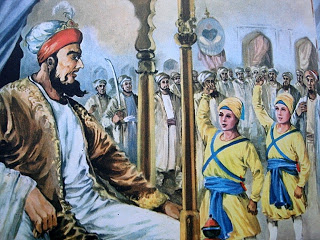
Symbolic Defiance – Saadi Jutti Dian Nokan Ne: As the Sahibzadas approached the closed gate of the court, a deliberate architectural setup awaited them, designed to enforce a symbolic act of submission. The only entry point was a small window, strategically positioned to necessitate bowing down before entering. Recognizing the Mughals’ plan to portray them bowing before imperial power, the intelligent Sahibzadas foiled this narrative. Instead, they boldly placed their feet forward, defying the expected gesture, and leaped through the window without bowing their heads. This act carried a profound symbolic message, asserting that the Sons of Guru Gobind Singh Ji, the Little Khalsas, held Mughal power beneath the soles of their shoes.
Triumphant Greeting – Gur Fateh Gajayee: Entering Nawab Wazir Khan’s court, the two Sahibzadas greeted the assembly with the resonant call of victory – “Wahguru Ji Ka Khalsa, Wahguru Ji Ki Fateh,” echoing through the halls. This proclamation of the Khalsa as God’s own and the victory belonging to God reverberated through the court, setting the stage for the unfolding confrontation between the young defenders of Sikh faith and the Mughal authority.
Unexpected Courage in the Court: The court, filled with important people, including Nawab Wazir Khan, was caught off guard by the unexpected boldness of the Sahibzadas. Dressed in saffron shirts, adorned with small swords around their wrists, the young Sahibzadas appeared both sweet and resolute.
Nawab’s Persuasion Attempt: Nawab Wazir Khan, seemingly affectionate, addressed the Sahibzadas, expressing pride that their youthful and brave faces would be an asset to Islam. He proposed that if they recited the Kalma (Muslim teachings), they would be welcomed into the Islamic fold, promising them anything they desired.
Sikhi’s Unwavering Stand: However, the Sahibzadas, undeterred, replied firmly, “We don’t care about worldly wealth. We will not abandon our religion at any cost.” Their resolute declaration, “Saada Ser Jaave tan Jaave, par Saada Sikhi Sidak Naa Jaave” (We can lay our lives but cannot leave Sikhi), was like a strong rebuke to Nawab Wazir Khan. Though annoyed, the Nawab chose to remain silent.
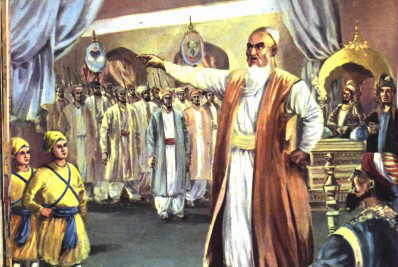
Nawab’s Frustration and Qazi’s Intervention: In discussions with the Qazi (Muslim priest), Nawab Wazir Khan expressed his frustration, considering the Sahibzadas as rebels who needed punishment. The Qazi, however, asserted that, according to Islamic law, the boys were not guilty of any crime. The Nawab, irritated by their perceived insolence, was taken aback by the unexpected support from the Qazi.
Unyielding Sahibzadas and Continued Threats: Despite the Qazi’s stance, Nawab Wazir Khan persisted, attempting to convince the Sahibzadas that they were still young and should enjoy life. He promised them a life of pleasure and a glorious afterlife in Paradise if they followed his advice. The Sahibzadas, however, stood firm, fearlessly declaring, “We are fighting against tyranny and injustice. We are ready for all sacrifices for the protection of our Sikhi.”
Nightly Strength from Mata Gujri Ji’s Stories: Each evening, after being brought back to Thanda Burj, the Sahibzadas found solace in listening to stories (Sakhis) from Mata Gujri Ji. Despite the daily threats and pressures in the court, the Sahibzadas remained resolute, unwavering in their commitment to Sikhi.
Encounter with Dewan Sucha Nand: In the following court session, Dewan Sucha Nand, a Moghul government official, approached the Sahibzadas, posing questions to gauge their intentions.
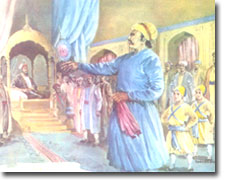
Sucha Nand’s Inquiry: Sucha Nand: “If you are set free, where will you go?”
Resolute Sahibzadas: Sahibzadas: “We will venture into the forests, reunite with fellow Sikhs, acquire strong horses, and return to confront you and your army on the battlefield.”
Unyielding Faith in Father’s Safety: Sucha Nand: “Do you know your father has been killed?”
Sahibzadas’ Firm Belief: Sahibzadas: “No one can harm our revered father. He will never fall into your hands.”
Defiant Declaration: In a resounding and defiant tone, the Sahibzadas proclaimed, “We don’t need advice from you. Listen carefully. Until this tyrannical government is completely eradicated, we will persist in our fight.”
Controversial Remark by Sucha Nand: Dewan Sucha Nand, taken aback, turned to the Nawab and remarked, “Sir, killing the serpent and feeding its young ones would not be wise. These young kids, when grown, will rebel against the government. They must be punished and should, under no circumstances, be released.” He controversially added, “Sons of snakes also bite like snakes; they should be eliminated.”
Consultation Among Nawab, Sucha Nand, and Qazi: While the Nawab, Sucha Nand, and the Qazi engaged in a conversation, the Sahibzadas, seemingly unaffected, continued conversing playfully with each other. The courtiers were astonished at their lack of fear, considering the gravity of their situation.
Dreadful Verdict by Qazi: Nawab, expressing concern to the Qazi, said, “You’ve heard their impertinent responses to Dewan Sucha Nand. It wouldn’t be safe to release them. They are likely to lead a rebellion, just like their father when they grow up.”
Harsh Sentence by Qazi: After careful consideration, the Qazi pronounced a harsh judgment, ordering that the Sahibzadas be bricked up alive in a wall.
Unwavering Resolve of Sahibzadas: While the courtiers were taken aback by the severe verdict, the Sahibzadas faced it without dismay, exhibiting unwavering strength and resolve.
Role of Nawab of Malerkotla: The Qazi suggested to Nawab Wazir Khan that the Sahibzadas be handed over to the Nawab of Malerkotla to execute the sentence. The Qazi believed that since the Nawab’s brother had lost his life at the hands of Guru Gobind Singh Ji, this would be an opportunity for revenge.
“Hand over the Sahibzadas to the Nawab of Malerkotla; he will seek vengeance from Guru Gobind Singh Ji by ending the lives of the Sahibzadas,” urged the Qazi.
Nawab Sher Mohammad and Qazi’s Proposal: Nawab Wazir Khan summoned Sher Mohammad, the Nawab of Malerkotla. The Qazi informed Nawab Malerkotla of the sentence, emphasizing the chance to avenge his brother’s death.
“The Qazi has sentenced these two sons of Guru Gobind Singh Ji to death and has ordered that they be bricked alive. We are entrusting them to you for the necessary action,” conveyed Nawab Wazir Khan. Sher Mohammad Khan was left stunned upon hearing this proposal.
Nawab of Malerkotla’s Ethical Stand: Nawab of Malerkotla (Sher Mohammad Khan) objected, stating, “This is cruelty! My brother met his fate on the battlefield. These innocent boys are not accountable for his death. If revenge is sought, it should be from the father. May God save us from this sinful act.” In a mournful tone, he expressed, “O God, how cruel!”
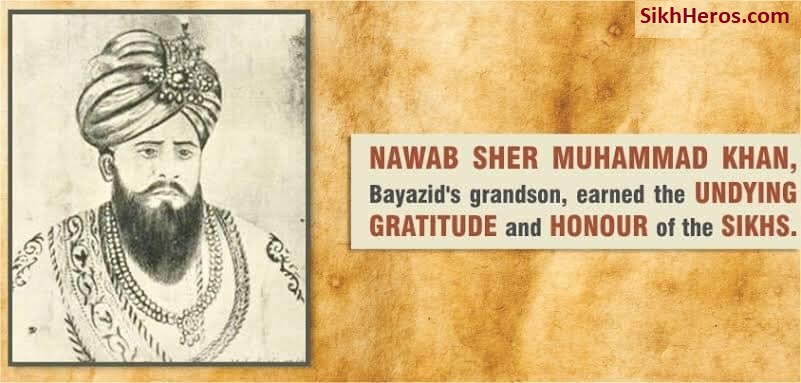
Sahibzadas Returned to Thanda Burj: Subsequently, the Nawab ordered the Sahibzadas to be returned to the tower. He instructed officials to arrange executioners to brick them alive between two walls, which were to be constructed immediately. The Sahibzadas reported the court proceedings to their grandmother, Mata Gujri Ji. She embraced her grandsons, commending their courageous stand and remarked, “You have rightfully upheld the dignity and honor of your revered grandfather and your valiant father. May God always abide with you.”
Nawab’s Final Proposal: The following morning, the Sahibzadas were escorted to the Nawab’s court once again. The Nawab reiterated, “I hope you have decided to embrace Islam; otherwise, as you know, you will face being bricked up alive.”
Sahibzadas Firm Rejection: In response, both Sahibzadas fearlessly declared, “We will never abandon our faith, regardless of the consequences. Death holds no fear for us.” The Nawab was astounded by their resolute and unwavering response.
Royal Executioners’ Offer: An official stepped forward, informing the Nawab that Shashal Beg and Bashal Beg, the two royal executioners from Delhi, were present and willing to carry out the order if granted a pardon. The Nawab granted them clemency under the condition that they brick up the two sons of Guru Gobind Singh Ji alive.
Cruel Observations from the Crowd: As the constables escorted the Sahibzadas, a large crowd gathered, expressing their dismay. Questions arose about the innocence of the young sons of Guru Gobind Singh Ji.
“What crime have they committed?” one questioned.
“How cruel and inhuman are Mughal rulers. O God!” exclaimed another.
“But they are not terrified,” noted a lady in the crowd.
“They are brave sons of their brave father, Guru Gobind Singh Ji,” remarked another lady.
The constables, perturbed by these comments, hastened their pace.
Site of Martyrdom: The Sahibzadas were brought to the designated spot where a wall was to be erected. They stood side by side in preparation.
Qazi’s Final Attempt: The Qazi arrived and made a final attempt to persuade them to embrace Islam, hoping to dissuade them from sacrificing their lives. The Qazi believed that the Sahibzadas, being young children, might fear a horrifying death and choose Islam over Sikhism.
Sahibzadas’ Urgent Request: In response, the Sahibzadas urged, “Raise the wall quickly. This will hasten the end of the Mughal Raj. Don’t delay for a minute.”
Rising of the Blood-Stained Wall: Following this, both Sahibzadas began reciting Jap Ji Sahib as the wall gradually rose brick by brick. The construction continued until it reached their chests.

Last Offering from Nawab and Qazi:
Approaching the Sahibzadas, the Nawab and Qazi spoke to them affectionately, “You still have time to save your lives. Just recite the Kalma, and the wall will be immediately pulled down.”
“Death Cannot Frighten Us” – Sahibzadas:
The Sahibzadas responded loudly, “We will not abandon our faith; death does not frighten us.” The steadfast determination of the Sahibzadas astonished both the Nawab and Qazi.
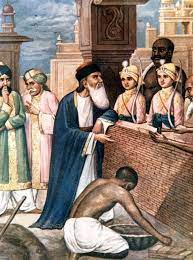
Tears welled up in the eyes of onlookers as they remarked, “Blessed is their mother who gave birth to such children.” The wall continued to rise, reaching shoulder height.
Final Exchange of Words between Sahibzadas:
Sahibzada Zorawar Singh spoke to his younger brother, “They are testing us. They do not realize that the Sikhs of Guru Nanak are fearless. Our Fifth Guru, Arjan Dev Ji, faced martyrdom cheerfully on burning iron pans. He not only guided humanity towards a truthful and noble life but also set an example of facing death boldly and with unwavering faith in God.”
The younger brother, Sahibzada Fateh Singh, remarked, “The martyrdom of our revered grandfather, Guru Tegh Bahadur Ji, was also unique. We shall soon join him. He is waiting for us.”
Sahibzadas Bricked Alive:
Subsequently, both Sahibzadas lost consciousness. The executioners, becoming nervous, conferred with each other. “They are nearing the end. There is no need to raise the wall further. Why not shorten their agony by beheading them? It is already getting dark.”
Martyrdom (Shaheedi):
As the wall fell, the unconscious Sahibzadas were brought out, laid flat on the ground, and instantly embraced martyrdom.
The onlookers in the crowd were shocked by this horrifying act, expressing their dismay, “What cruelty!”
In Fatehgarh Sahib, the incident of Guru Gobind Singh’s Sahibzadas choosing to face the wall before being bricked was a moment of pride for the Sikh community. As the wall was being constructed, the Sahibzadas began reciting ‘Japji Sahib.’ Once the wall was complete and cheers were heard from inside, it was broken, and although the children were alive, they were forcibly killed. On the other hand, upon hearing the news of the martyrdom of the Sahibzadas, Mata Gujri Ji, Guru Gobind Singh’s mother, expressed gratitude to the Almighty for this proud sacrifice and embraced martyrdom.
Mata Ji’s Departure: Upon the martyrdom of the two Sahibzadas, Mata Gujri Ji, who had been meditating in the tower, breathed her last.
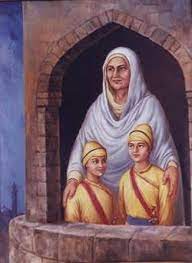
Mata Gujri (1624-1705), formally known as Mata Gujar Kaur, held a significant role in the Sikh community. She was the devoted wife of the ninth Sikh Guru, Guru Tegh Bahadur, and the mother of the tenth and final human Sikh Guru, Guru Gobind Singh. Additionally, she was the grandmother of the four Sahibzade.
Born in 1624 to Bhai Lal Chand Subulikka and Bishan Kaur, a deeply religious couple from Kartarpur in the present-day Kapurthala district of Punjab, Mata Gujri played a crucial role in the evolution of the Sikh faith.
Her life was intertwined with sacrifice and martyrdom. As the wife of Guru Tegh Bahadur, who became a supreme martyr, and the mother of Guru Gobind Singh, a courageous saint-soldier, Mata Gujri’s lineage continued with four remarkable grandchildren who all attained martyrdom at tender ages—6, 9, 14, and 18 years.
During the flight from Anandpur, Mata Gujri took on the guardianship of the two younger Sahibzade and remained close to them. Unfortunately, they were imprisoned in the Thanda Burj of Sirhind. At the age of 81, she faced martyrdom upon learning of the execution of her youngest grandsons, Sahibzada Zorawar Singh and Sahibzada Fateh Singh. Her unwavering commitment to her faith and her sacrifices have left an indelible mark on Sikh history.
The messenger bearing the news of the Sahibzads’ martyrdom discovered that Mata Ji had already attained salvation.
Outrage Against the Cruel Mughal Empire: A great commotion swept through the town of Sirhind. The populace was incensed by this atrocious crime, unanimously believing that it signaled the downfall of the Moghul Empire.
The courage and steadfastness of the brave sons of Guru Gobind Singh Ji were widely admired. Observers remarked, “What determination at such a young age! They did not waver from their position despite numerous temptations from the Nawab and Qazi.”
Devotion of Diwan Todar Mal: Later that evening, Dewan Todar Mal, a devoted Sikh and a jeweler, approached Nawab Wazir Khan’s court, seeking permission to cremate the bodies of the two Sahibzadas and Mata Gujri Ji.
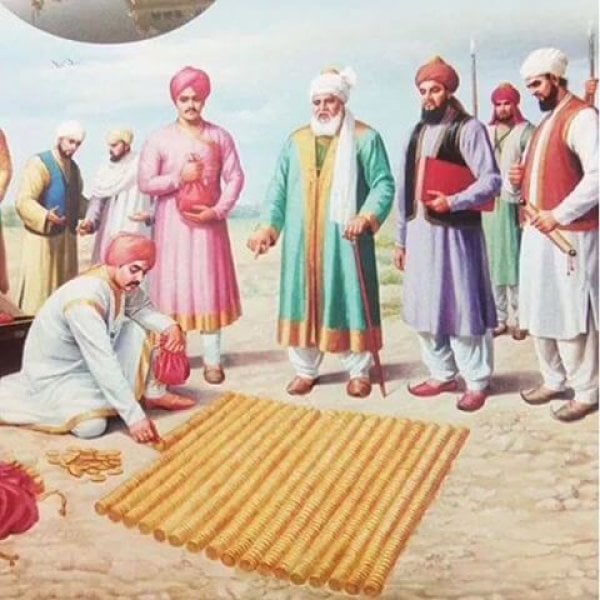
The Nawab granted permission under the condition that Dewan paid for the necessary land by covering the entire spot with as many gold coins as possible.
Dewan Todar Mal accepted the terms, bringing bagfuls of gold coins. He marked the site, spreading coins across the selected land. When he began laying coins, Wazir Khan suggested placing them vertically in a standing form to maximize coverage.
Gurudwara Jyoti Saroop Sahib: The two martyred sons of Guru Gobind Singh Ji were cremated with full honors, alongside their grandmother. Today, Gurudwara Jyoti Saroop Sahib stands at the place where the Sahibzadas were cremated.
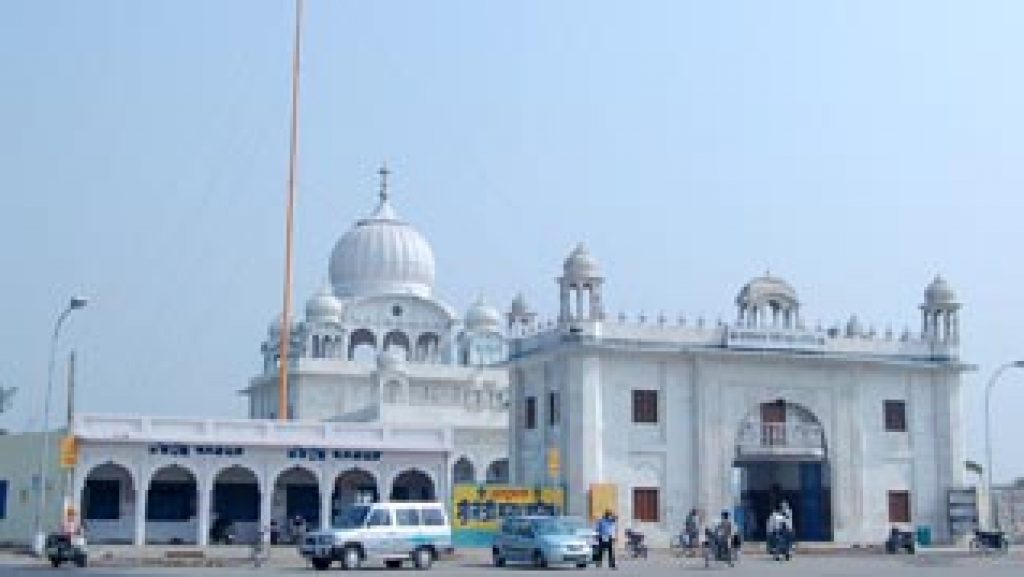
Two younger Sahibzadas and Mata Gujri were cremated by a devout Sikh, Diwan Todar Mal, at a spot, know known as Joyti Saroop Gurudwara.
Unparalleled Martyrdom: The martyrdom of these young boys in December 1705 is unparalleled in human history. Sahibzada Baba Fateh Singh Ji was seven years old, and Sahibzada Baba Zorawar Singh Ji was nine years old. Despite being bricked alive, they refused to bow before the tyranny of the Mughal government.
Martyrdom Uprooting the Mughal Raj: Upon hearing the news of his younger sons’ martyrdom, Guru Gobind Singh Ji, in the forests of Machhiwara, pulled out a plant with the tip of his arrow, prophesying that this tragedy would mark the uprooting of the Mughal Empire.
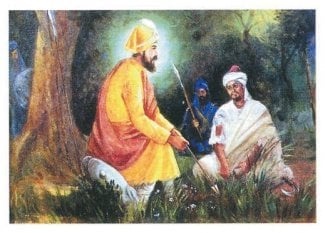
Guru Gobind Singh Ji addressed his followers, stating, “The Sahibzadas are sacrificed for the survival of the thousands of my children who are still alive” (all Sikhs are considered Guru Gobind Singh’s sons and daughters).
Nawab’s Tragic Turn of Fate
The Nawab’s troubles extended beyond his political challenges. His wife, Zai-bul-nisa, affectionately known as Zaina Begum, faced a tragic fate. Despite being abducted on her way to marriage, she was married off to a young man in Sirhind. However, after the Nawab’s ruthless orders regarding the Sahibzadey, the Begum, distressed by the events, confronted the Nawab and took her own life by stabbing herself with a poniard.
Following the death of Aurangzeb, his sons engaged in a power struggle for the imperial throne. Seeking Guru Gobind Singh’s assistance, the eldest son, Bahadur Shah, emerged victorious, becoming the Emperor. He honored the Guru in Agra, and together, they traveled to the South.
While Guru Ji camped at Nanaded, Bahadur Shah continued his journey further south. During this time, Guru Ji encountered a Kashmiri hermit named Madho Das Lachhaman Das Bairagi. Impressed by Guru Ji, Madho Das became his disciple after taking Amrit. Renamed Banda Singh Bahadar, he was entrusted by Guru Ji with the leadership of his men, along with weapons and letters for the Sangat to fulfill his mission. Additionally, five Sikhs were sent to assist Banda Singh as needed.
Baba Banda Singh and the Erasure of Sirhind: In time, Guru Gobind Singh Ji blessed Baba Banda Singh Bahadur, who shook the Mughal Empire, erasing Sirhind and establishing the first Great Sikh Raaj. Today, Sirhind is renamed Fatehgarh Sahib after the youngest Sahibzada Baba Fateh Singh Ji, and Gurudwara Fatehgarh Sahib stands at the place where the Sahibzadas were bricked alive and martyred.
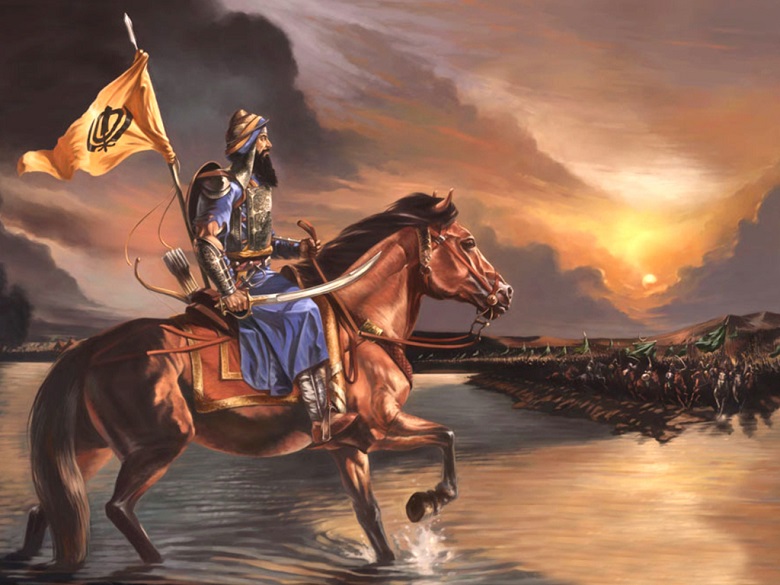
Victory in Sirhind and Dispensing Justice
In the year 1710, Baba Banda Singh Bahadur successfully captured Sirhind and ensured justice by punishing those accountable for committing heinous acts. The perpetrators of the atrocities against the Sahibzaade and Bhai Moti Ram’s family faced consequences. Sucha Nand, the wrongdoer, was subjected to a beating, had a bull’s ring inserted into his nose, and was compelled to beg from the very people he had exploited for numerous years. Ultimately, he met his demise.
Nawaab Wazir Khan was killed, and his body was tied to a donkey, dragged through the entirety of Sirhind as a public display. Baba ji also sought out individuals who had shown loyalty by aiding Guru ji and serving Mata ji and the Sahibzaade. Bhai Kareem, the boatman, who later embraced Amrit and became Bhai Karam Singh ji, along with Bibi Lakshmi ji from a Brahmin family, received honors from the Khalsa and expressions of gratitude.
In Loving Memory: Gurdwara Fatehgarh Sahib
The location where the tragic events unfolded, now named Fatehgarh Sahib, near the old town of Sirhind, is adorned with four Sikh Gurdwara Sahibs. A significant religious fair, Jorr-Mela, takes place there annually from December 25th to 28th, dedicated to honoring the memory of these esteemed martyrs.
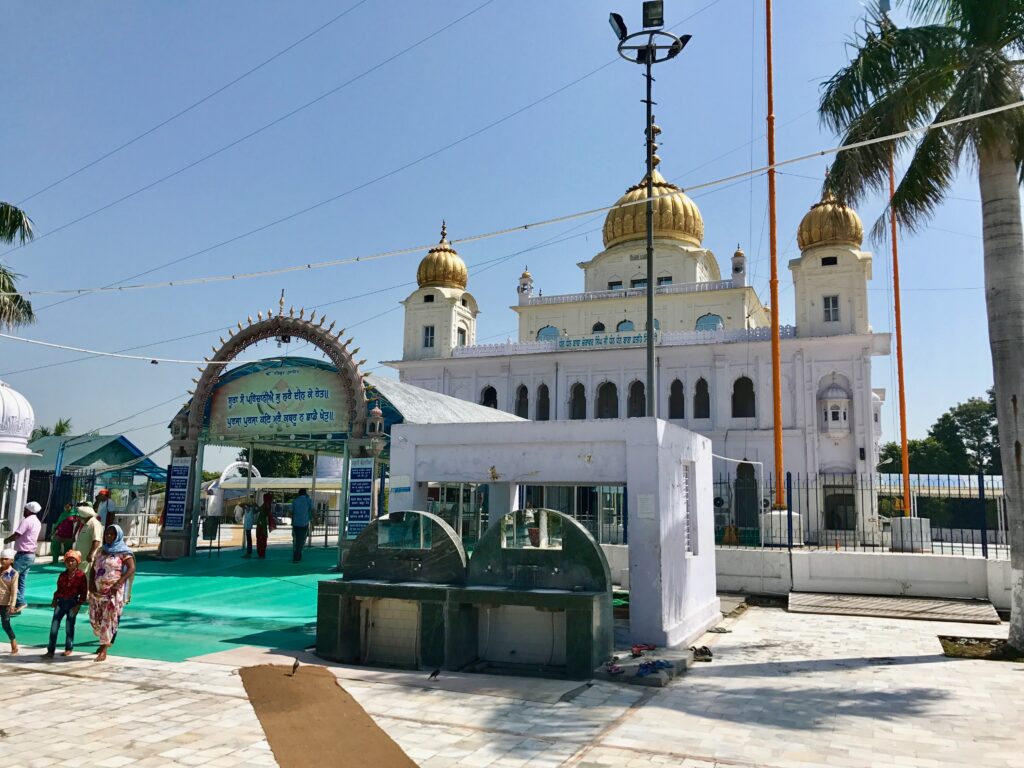
The Chhotte Sahibzade (Punjabi: ਛੋਟੇ ਸਾਹਿਬਜ਼ਾਦੇ) of Guru Gobind Singh embraced martyrdom on December 26, 1705, at a tender age. This event is known as Saka Sirhind. Each year on December 26, Shaheedi Jor Mela is organized at Fatehgarh Sahib to commemorate the supreme sacrifice made at the site of their martyrdom.
| Event | Samat Bikrmi Date | Year |
|---|---|---|
| Leaving of Anandpur Sahib | 5 Poh | 1761 |
| Battle of Chamkaur | 6, 7, and 8 Poh | 1761 |
| Saka Sirhind | 11, 12, and 13 Poh | 1761 |
Shaheedi Sabha at Fatehgarh Sahib: Every year, in the last days of December, Sikhs from around the world gather at Fatehgarh Sahib for the Shaheedi Sabha to remember the sacrifice of the Sahibzadas.
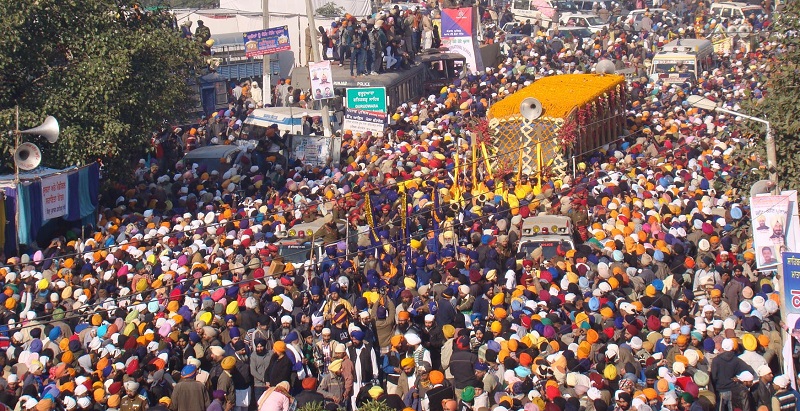
History Summary:
In 1704, Mughal and Hilly Rajas’ forces besieged Anandgarh Fort, Anandpur Sahib, for 8 months. They promised Guru Gobind Singh a safe passage if he left the fort, but they betrayed the vow and attacked the Guru’s entourage at Sarsa rivulet. The family separated, and Mata Gujri with two younger grandsons was arrested. The Chamkaur battle occurred on December 22-23, 1704, where two elder Sahibzadas, 3 Panj Piaras, and 40 Sikhs sacrificed their lives. The heinous act took place in Sirhind on December 27, 1704, where Baba Fateh Singh and Baba Zorawar Singh were bricked alive and killed. Mata Gujri and the younger Sahibzadas were later cremated at Joyti Saroop Gurudwara by a devout Sikh, Diwan Todar Mal.
Early Life and Profound Teachings of Baba Zorawar Singh Ji, Baba Fateh Singh Ji, and Mata Gujar Kaur Ji
The lives of Baba Zorawar Singh Ji, Baba Fateh Singh Ji, and Mata Gujar Kaur Ji stand as luminous beacons in Sikh history, radiating the virtues of courage, sacrifice, and unwavering faith. In this exploration, we delve into the early years and teachings of these revered figures, seeking to unravel the profound impact they had on shaping Sikh philosophy and inspiring generations.
Early Life: Nurturing the Seeds of Virtue
Baba Zorawar Singh Ji
Born on 28th November 1696, Baba Zorawar Singh Ji was the youngest son of Guru Gobind Singh Ji. From an early age, he was immersed in the teachings of Sikhism, imbibing the principles of equality, compassion, and fearlessness.
Baba Fateh Singh Ji
Baba Fateh Singh Ji, born on 25th February 1699, displayed a natural affinity for spirituality. Growing up in the revered environment of Anandpur Sahib, he absorbed the essence of Sikh values under the guidance of Guru Gobind Singh Ji.
Mata Gujar Kaur Ji
The mother of these brave souls, Mata Gujar Kaur Ji, played a pivotal role in nurturing their spiritual and moral foundations. Her teachings emphasized the importance of selfless service, humility, and devotion to the Guru.
Teachings: Wisdom Beyond Years
Fearlessness in the Face of Adversity
One of the central teachings of Baba Zorawar Singh Ji and Baba Fateh Singh Ji is the virtue of fearlessness. Despite their tender age, they faced the brutalities of the time with unyielding courage, echoing the Sikh principle of standing against oppression.
Devotion to the Guru
Mata Gujar Kaur Ji instilled in her sons a deep devotion to Guru Gobind Singh Ji. The teachings emphasized the Guru as the guiding light, and this devotion became the cornerstone of their unwavering commitment to Sikh principles.
Sacrifice for Principles
The ultimate sacrifice made by Baba Zorawar Singh Ji and Baba Fateh Singh Ji at the tender ages of 9 and 6, respectively, exemplifies their commitment to principles. Their martyrdom underscores the Sikh belief that certain values are non-negotiable, even in the face of extreme adversity.
Baba Zorawar Singh Ji
Baba Zorawar Singh Ji: A Radiant Beacon of Sacrifice and Devotion
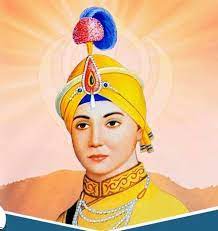
Early Years and Spiritual Upbringing
Baba Zorawar Singh Ji, the embodiment of Sikh virtues, was born on 28th November 1696, to Guru Gobind Singh Ji and Mata Sundari Ji. From his earliest days, he was enveloped in an aura of spirituality, growing up in the sacred environment of Anandpur Sahib.
Spiritual Mentorship by Guru Gobind Singh Ji
Under the guidance of Guru Gobind Singh Ji, Baba Zorawar Singh Ji imbibed the essence of Sikh teachings. His spiritual education emphasized the principles of humility, compassion, and unwavering commitment to righteousness.
During the harrowing journey, Baba Zorawar Singh Ji, along with his younger brother Baba Fateh Singh Ji, exhibited remarkable bravery. The two young souls, aged 8 and 5, respectively, faced the trials of hunger, fatigue, and the brutal winter with indomitable courage.
Gurdwaras and Sacred Sites
Gurdwaras, such as Fatehgarh Sahib and Keshgarh Sahib, stand as monuments to honor the sacrifice of Baba Zorawar Singh Ji and Baba Fateh Singh Ji. Pilgrims visit these sites to pay homage and seek inspiration from their unparalleled devotion.
Gurbani Shabads: A Spiritual Connection
As we reflect on the life of Baba Zorawar Singh Ji, the following Gurbani Shabads resonate with the spirit of sacrifice and unwavering devotion:
"ਜਿਉ ਤੂੰ ਅਆਇਆ ਪੰਚੇ ਇਸੁ ਤਨ ਮਹਿ ਸਾਚਾ ਪਿਆਰੁ ॥" (As You came, so did I receive true love in this body.)
"ਜੋ ਪ੍ਰਭ ਕਉ ਮਿਲਬੋ ਚਾਹੈ ਖੋਜਤ ਖੋਜਤ ਹਰਿ ਲੋਗੁ ਹੋਇ ॥" (One who desires to meet God must search, searching, and the Lord, in the end, shall be found.)Baba Zorawar Singh Ji’s life stands as a testament to the enduring spirit of sacrifice and devotion. His unwavering commitment to Sikh principles, even at a tender age, illuminates the path for generations to come, urging us to emulate his courage and fidelity to righteousness.
Baba Zorawar Singh Ji, born on 28th November 1696, belonged to the illustrious lineage of Guru Nanak Dev Ji, the founder of Sikhism. This sacred lineage instilled a deep sense of spiritual responsibility in Baba Zorawar Singh Ji from his very inception.
According to the Nanakshahi calendar, from December 20th to 27th, Sikhs observe Martyrdom Week. During these days, large-scale Kirtan and prayers take place in Gurudwaras and homes. Children are told about the martyrdom of Guru Sahib’s family. Many devout Sikhs also sleep on the ground for the entire week, paying homage to the martyrdom of Mata Gujri and the Sahibzadas. In reality, amidst the biting cold, Mata Gujri and the two younger Sahibzadas were imprisoned in the Thanda Burj of Sirhind.
These brave sacrifices have no match in any religion worldwide. They are like precious stories in Sikh history that will be remembered forever.

